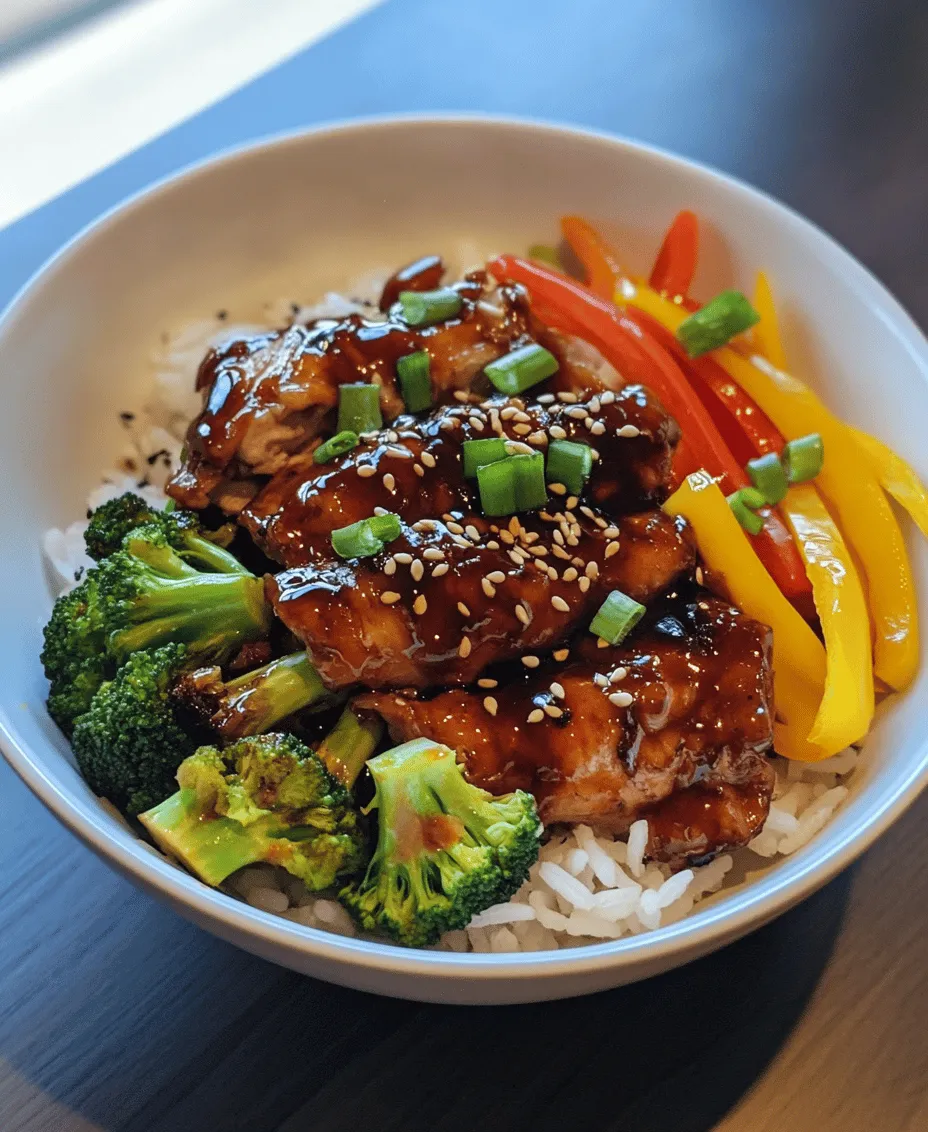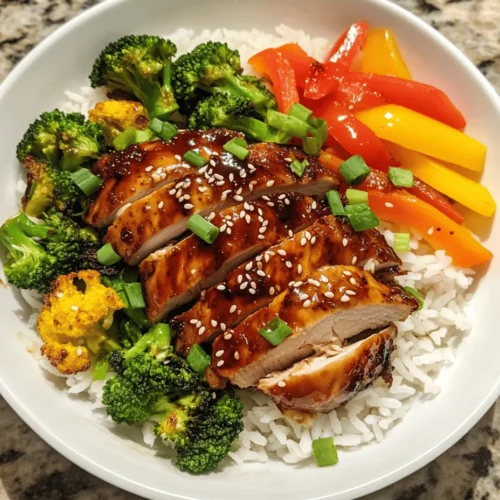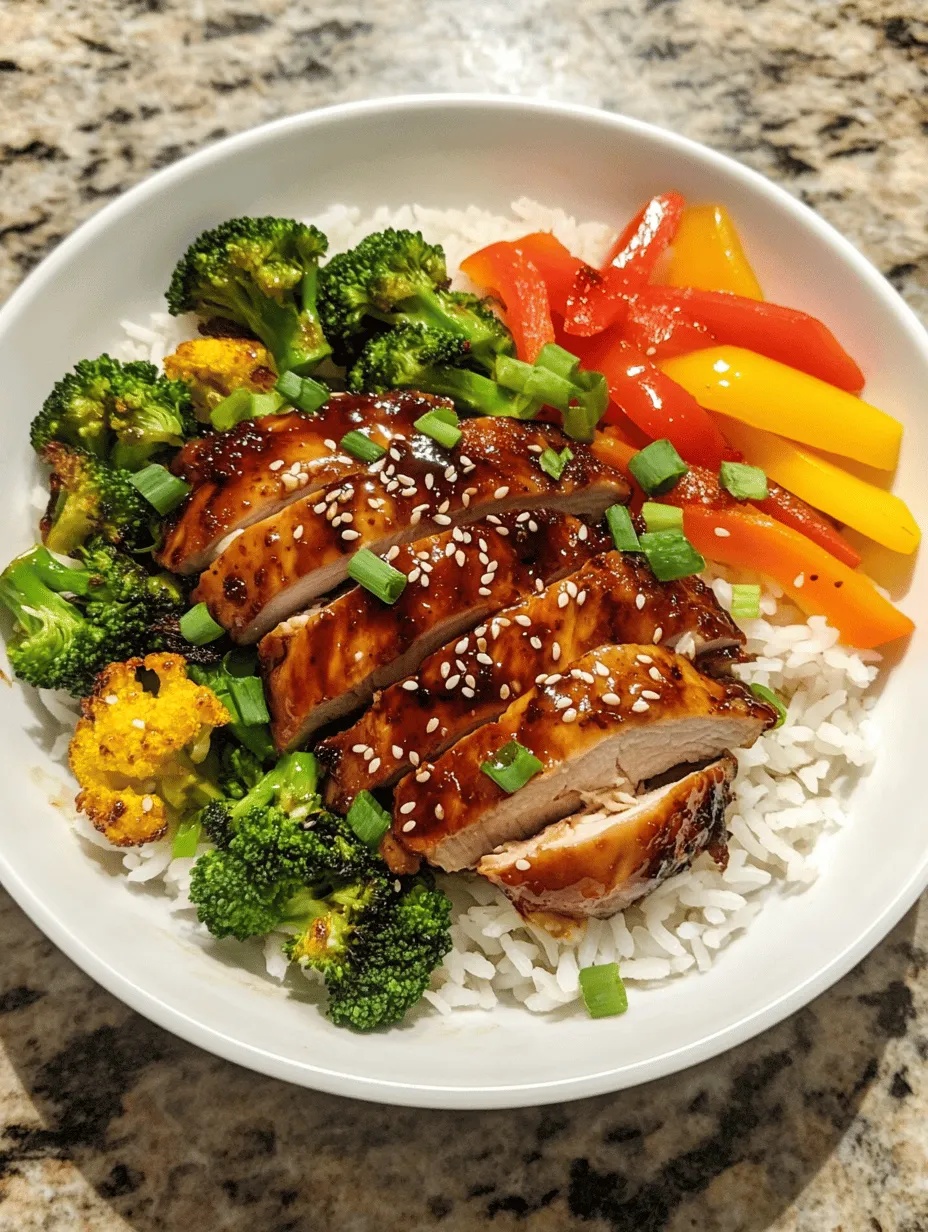Introduction
The Teriyaki Chicken Rice Bowl is a delightful dish that perfectly encapsulates the essence of Japanese cuisine while appealing to a global palate. With its harmonious balance of savory, sweet, and umami flavors, this dish has gained popularity far beyond its origins. The Teriyaki Chicken Rice Bowl not only offers a satisfying dining experience but also showcases the beauty of homemade meals, which foster health and a deeper connection to culinary traditions.
The allure of this recipe lies in its simplicity and versatility. It’s a quick and easy meal that can be prepared in under 30 minutes, making it ideal for busy weeknights. The fusion of flavors from the teriyaki sauce, combined with tender chicken and a medley of colorful vegetables, creates a wholesome dish that is both nourishing and visually appealing. As you prepare this meal in your kitchen, you’ll find that it promotes a sense of satisfaction and accomplishment, as well as an opportunity to explore and appreciate Japanese culinary culture.
Understanding Teriyaki: A Culinary Tradition
To fully appreciate the Teriyaki Chicken Rice Bowl, it’s essential to understand the origins and significance of teriyaki sauce. Teriyaki, which translates to “to grill” or “to broil” in Japanese, is a cooking technique that dates back to the 17th century. The method involves marinating meat in a mixture of soy sauce, sake, mirin, and sugar, then grilling or broiling it until it reaches a glossy, caramelized finish. This cooking technique not only enhances the flavor of the meat but also creates a beautiful glaze that is visually enticing.
The cultural significance of teriyaki in Japanese cuisine cannot be understated. It reflects the country’s emphasis on fresh ingredients, seasonality, and the artistry of cooking. Teriyaki sauce is a staple in many Japanese households and restaurants, often used to flavor chicken, beef, and fish, and even as a dipping sauce. The balance of sweetness and saltiness in teriyaki sauce is achieved through a careful combination of ingredients, which we’ll explore in detail.
Common Ingredients that Define Teriyaki Flavors
At the heart of teriyaki sauce are several key ingredients that create its distinctive flavor profile. These include:
– Soy Sauce: The primary ingredient in teriyaki sauce, soy sauce imparts a rich umami flavor and saltiness that enhances the overall taste of the dish.
– Mirin: A sweet rice wine that adds depth and complexity to the sauce, mirin also contributes a subtle sweetness that balances the saltiness of the soy sauce.
– Sugar: Brown sugar is often used in teriyaki recipes to enhance sweetness and create a glossy finish when caramelized.
– Rice Vinegar: This adds a touch of acidity, which helps to balance the sweetness and umami flavors, providing depth to the sauce.
– Sesame Oil: A small amount of sesame oil adds a rich, nutty aroma and flavor that complements the other ingredients.
– Garlic and Ginger: These aromatic ingredients are essential for creating a well-rounded marinade, adding warmth and depth to the dish.
Together, these ingredients create a sauce that is both flavorful and versatile, making it a perfect choice for various proteins and vegetables.
Ingredients Breakdown
To create a delicious Teriyaki Chicken Rice Bowl, you’ll need a selection of fresh ingredients that work together to deliver authentic flavors. Below is an overview of the key components required for this recipe:
Key Ingredients
– Chicken: For this recipe, boneless, skinless chicken thighs are recommended. They provide a juicy and tender texture that holds up well to the bold flavors of the teriyaki sauce. Chicken thighs are also more forgiving during cooking compared to chicken breasts, which can dry out more easily.
– Soy Sauce: The backbone of the teriyaki sauce, soy sauce is essential for imparting that signature umami flavor. Opt for a low-sodium variety if you prefer a milder taste or are watching your salt intake.
– Brown Sugar: This ingredient is crucial for balancing the savory elements of the dish. The caramelization of brown sugar during cooking enhances the overall flavor and provides a rich, glossy finish.
– Rice Vinegar: Adding a splash of rice vinegar elevates the dish by cutting through the sweetness of the sugar and providing a refreshing acidity that brightens the flavors.
– Sesame Oil: A small drizzle of sesame oil adds depth and an aromatic quality that rounds out the flavor profile of the dish.
– Garlic and Ginger: These two ingredients serve as the aromatic foundation for the marinade. Fresh garlic and ginger provide warmth and a depth of flavor that is essential for any teriyaki recipe.
– Vegetables: A selection of fresh vegetables such as bell peppers, broccoli, and snap peas not only adds nutritional benefits but also contributes a burst of color and texture to the dish.
– Jasmine Rice: This fragrant rice variety is the perfect base for the rice bowl, providing a light and fluffy foundation that pairs beautifully with the saucy chicken and vegetables.
Importance of Each Ingredient
Each ingredient in the Teriyaki Chicken Rice Bowl plays a vital role in achieving authentic flavors and a satisfying texture:
– Chicken Thighs: Their higher fat content compared to chicken breasts ensures a juicy, tender bite that absorbs the teriyaki marinade beautifully.
– Soy Sauce: It provides the essential umami taste, making every bite rich and satisfying.
– Brown Sugar: The sweetness balances the salty soy sauce, creating a complex flavor that is both comforting and exciting.
– Rice Vinegar: It elevates the dish by adding a brightness that cuts through the richness of the other ingredients.
– Sesame Oil: Enhances the overall aroma and depth of flavor, making the dish feel more authentic.
– Garlic and Ginger: These aromatics not only add flavor but also offer health benefits, such as anti-inflammatory properties.
– Vegetables: They provide essential vitamins and minerals, as well as a nice crunch that contrasts with the tender chicken and fluffy rice.
– Jasmine Rice: Its delicate flavor complements the teriyaki sauce without overpowering it, making it the ideal canvas for the dish.
Step-by-Step Preparation Guide
Now that we’ve covered the ingredients and their significance, it’s time to dive into the preparation of the Teriyaki Chicken Rice Bowl. The first step involves creating the marinade that will infuse the chicken with flavor.
Preparing the Marinade: Techniques for Optimal Flavor Infusion
1. Combine the Ingredients: In a mixing bowl, combine the soy sauce, brown sugar, rice vinegar, sesame oil, minced garlic, and grated ginger. Whisk together until the sugar is fully dissolved and the mixture is well blended.
2. Marinate the Chicken: Place the boneless, skinless chicken thighs into a resealable plastic bag or a shallow dish. Pour the marinade over the chicken, ensuring that each piece is thoroughly coated. Seal the bag or cover the dish and refrigerate for at least 30 minutes, or up to 2 hours for maximum flavor. The longer the chicken marinates, the more pronounced the flavors will be.
3. Prepare the Vegetables: While the chicken is marinating, wash and chop your chosen vegetables into bite-sized pieces. This can include bell peppers, broccoli, carrots, and snap peas – any combination you prefer. Set them aside to be sautéed later.
4. Cook the Rice: Begin cooking the jasmine rice according to the package instructions. Typically, this involves rinsing the rice under cold water, bringing it to a boil with the appropriate amount of water, then lowering the heat and allowing it to simmer until tender. Fluff the rice with a fork once cooked, and keep it warm.
5. Cook the Chicken: After marinating, heat a large skillet or non-stick frying pan over medium heat. Add a little oil to the pan, then remove the chicken from the marinade (reserving the marinade for later use) and place it in the hot skillet. Sear the chicken for about 5-6 minutes on each side, or until it is cooked through and has a nice golden-brown color.
6. Add the Vegetables: Once the chicken is cooked, remove it from the skillet and let it rest for a few minutes before slicing it into thin strips. In the same skillet, add the chopped vegetables and sauté for 3-4 minutes, or until they are tender-crisp.
7. Create the Sauce: Pour the reserved marinade into the skillet with the sautéed vegetables, bringing it to a simmer. Allow it to cook for a few minutes, stirring occasionally, until it thickens slightly. This will create a delicious sauce to drizzle over the chicken and rice.
8. Assemble the Bowl: To assemble the Teriyaki Chicken Rice Bowl, start with a generous scoop of jasmine rice at the bottom of the bowl. Top it with sliced teriyaki chicken and a colorful array of sautéed vegetables. Drizzle the thickened teriyaki sauce over the top for added flavor.
With these steps completed, you’ll have a stunning Teriyaki Chicken Rice Bowl that showcases the beautiful flavors of Japanese cuisine while providing a hearty and nutritious meal for you and your loved ones. Stay tuned for the next part, where we will delve into tips for achieving the best results and address some common questions regarding this delightful recipe.

Marinating the Chicken
Marinating is a crucial step when preparing Teriyaki Chicken, as it allows the flavors to penetrate the meat, resulting in a more flavorful dish. For optimal results, marinate the chicken for at least 30 minutes; however, if time allows, aim for 1-2 hours. Overnight marinating can yield even deeper flavors, but be cautious not to exceed 24 hours, as the acidity from the marinade may begin to alter the chicken’s texture.
When marinating, use a resealable plastic bag or a glass container to ensure the chicken is fully coated. Remember to reserve some of the marinade for later use in the sauce, which will enhance the overall flavor of the dish.
Cooking Techniques for Chicken
To achieve tender and caramelized chicken, the cooking method you choose is essential. Here are two popular techniques:
1. Grilling: For a smoky flavor, preheat your grill to medium-high. Remove the chicken from the marinade, allowing excess liquid to drip off. Grill the chicken for about 6-7 minutes on each side, or until the internal temperature reaches 165°F (75°C). This method not only produces a delightful char but also seals in moisture.
2. Sautéing: If you prefer to cook indoors, a non-stick skillet or wok works perfectly. Heat a tablespoon of oil over medium-high heat, then add the marinated chicken. Cook for about 5-6 minutes per side, allowing the pieces to brown nicely. For added depth, you can pour a bit of the reserved marinade into the pan during the last few minutes of cooking, letting it reduce and glaze the chicken.
Regardless of the cooking method, avoid overcrowding the pan or grill to ensure even cooking and caramelization.
Thicken the Sauce
Creating a thick, glossy teriyaki sauce is essential for your rice bowl. If your sauce is too thin, it may not cling to the chicken or vegetables effectively. Here are a couple of options for achieving the perfect consistency:
– Cornstarch Slurry: Mix equal parts cornstarch and cold water (about 1 tablespoon of each). Bring your teriyaki sauce to a simmer, then gradually whisk in the slurry. Continue to cook for a few minutes until the sauce thickens to your desired consistency.
– Reduction: If you prefer a more natural thickening method, simmer the teriyaki sauce over low heat until it reduces and thickens. This method will enhance the flavor as well, concentrating the sweetness and umami notes.
Stir-Frying Vegetables
Vegetables add color, texture, and nutrition to your Teriyaki Chicken Rice Bowl. The key to stir-frying is to cook the vegetables quickly over high heat, which helps retain their crunch and bright colors. Choose a mix of vegetables such as bell peppers, broccoli, and snap peas for a vibrant dish.
1. Preparation: Chop your vegetables into uniform pieces to ensure even cooking.
2. Cooking: In a hot skillet or wok, add a tablespoon of oil. Begin with the denser vegetables, like carrots and broccoli, cooking for about 2-3 minutes before adding quicker-cooking options like bell peppers and snap peas. Stir-fry for an additional 2-3 minutes until they are tender-crisp.
3. Flavoring: You can drizzle a small amount of the teriyaki sauce over the vegetables during the last minute of cooking for an added burst of flavor.
Assembling the Rice Bowl
Now that the chicken and vegetables are prepared, it’s time to assemble your Teriyaki Chicken Rice Bowl. Start with a base of perfectly cooked rice; jasmine or short-grain sushi rice works exceptionally well for this dish.
1. Layering: Spoon a generous portion of rice into each bowl. Next, add the sautéed vegetables, followed by the sliced teriyaki chicken arranged attractively on top.
2. Presentation Tips: To make your dish visually appealing, consider arranging the chicken in a fan shape and placing the vegetables in a way that showcases their vibrant colors.
3. Final Touch: Drizzle additional teriyaki sauce over the top for a glossy finish, and consider adding sesame seeds for a touch of elegance.
Garnishing
Garnishing your Teriyaki Chicken Rice Bowl not only enhances its visual appeal but also adds layers of flavor. Here are some ideas:
– Green Onions: Finely slice green onions and sprinkle them over the top for a fresh, slightly sharp contrast.
– Sesame Seeds: Toasted sesame seeds offer a nutty flavor and crunch that complements the dish beautifully.
– Nori Strips: Thin strips of nori (seaweed) can add an umami kick and an appealing texture.
– Pickled Ginger: Adding a bit of pickled ginger on the side can provide a refreshing palate cleanser to balance the richness of the teriyaki sauce.
Nutritional Information
Understanding the nutritional benefits of your Teriyaki Chicken Rice Bowl can enhance your appreciation for the dish. Here’s a breakdown:
– Caloric Breakdown: A typical serving of Teriyaki Chicken Rice Bowl contains approximately 500-600 calories, depending on portion sizes and any added ingredients.
– Health Benefits: Chicken is an excellent source of lean protein, essential for muscle repair and overall health. The vegetables provide important vitamins and minerals, while the teriyaki sauce, when made with natural ingredients, can be a source of antioxidants.
– Balanced Meal: This dish is well-rounded, offering a balance of protein from the chicken, carbohydrates from the rice, and fiber from the vegetables, making it a fulfilling meal option.
Flavor Variations and Substitutions
To cater to various dietary needs or personal preferences, consider these variations and substitutions:
– Gluten-Free Option: Use tamari instead of traditional soy sauce to make the teriyaki sauce gluten-free.
– Vegetarian/Vegan Adaptations: Substitute chicken with tofu or tempeh, marinating and cooking them in the same way as the chicken.
– Alternative Proteins: Shrimp or fish (like salmon) can also work beautifully with teriyaki sauce, providing a different flavor profile.
– Seasonal Vegetables: Incorporate seasonal vegetables such as zucchini, asparagus, or whatever is fresh from your local market to keep the dish interesting throughout the year.
– Adjusting Sweetness: If you prefer less sweetness, reduce the amount of sugar or honey in your teriyaki sauce. Alternatively, you can add a splash of rice vinegar for acidity to balance the flavors.
Pairing Suggestions
Enhancing your Teriyaki Chicken Rice Bowl with the right beverages and side dishes can elevate your meal experience:
– Beverages: Consider pairing your dish with Japanese green tea, which offers a subtle flavor that complements the teriyaki sauce. Sake is another excellent choice, providing a unique pairing with the dish’s umami notes.
– Side Dishes: Miso soup is a classic accompaniment that can provide warmth and depth. Edamame, served lightly salted, adds a protein-packed side that complements your meal.
– Presentation Ideas: For special occasions, serve your rice bowls on attractive wooden or ceramic dishes, and consider using chopsticks for an authentic experience.
Conclusion
The Teriyaki Chicken Rice Bowl is not only delicious but also an easy and satisfying dish to prepare at home. Its versatility allows for personal customization, making it a perfect meal for every palate. Whether you’re following the traditional recipe or experimenting with your own variations, this dish is sure to impress.
Homemade meals like this one not only nurture your body but also create opportunities for cultural appreciation and family bonding through cooking. So gather your ingredients, embrace your creativity, and enjoy the culinary journey of making your own Teriyaki Chicken Rice Bowl!



